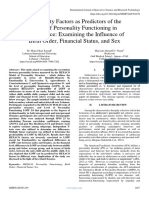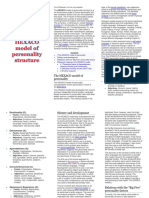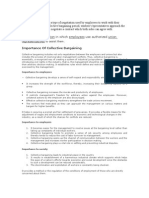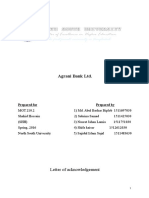Objectives of Collective Bargaining
Objectives of Collective Bargaining
Uploaded by
Shivam BoseCopyright:
Available Formats
Objectives of Collective Bargaining
Objectives of Collective Bargaining
Uploaded by
Shivam BoseOriginal Description:
Original Title
Copyright
Available Formats
Share this document
Did you find this document useful?
Is this content inappropriate?
Copyright:
Available Formats
Objectives of Collective Bargaining
Objectives of Collective Bargaining
Uploaded by
Shivam BoseCopyright:
Available Formats
Collective Bargaining
Good relations between the employer and employees are essential for the success of industry. In
order to maintain good relations, it is necessary that industrial disputes are settled quickly and
amicably. One of the efficient methods of resolving industrial disputes and deciding the employment
conditions is Collective Bargaining. Industrial disputes essentially refer to differences or conflicts
between employers and employees.
Collective Bargaining is a process in which the management and employee
representatives meet and negotiate the terms and conditions of employment for mutual benefit.
Collective bargaining involves discussion and negotiation between two groups as to the terms and
conditions of employment. It is termed Collective because both the employer’s negotiators and the
employees act as a group rather than individuals. It is known as Bargaining because the method of
reaching an agreement involves proposals and counter-proposals, offers and counter offers. There
should be no outsiders involved in the process of collective bargaining.
According to Walton and McKersie the process of Collective Bargaining consists of four types of
activities:
1) Distributive Bargaining: It involves haggling over the distribution of surplus. Various activities
involved in this activity are wages, salaries, bonus and other financial issues. In this activity, both
the parties face a win/lose situation.
2) Integrative Bargaining: Also known as Interest-Based Bargaining, issues which are not damaging to
either party are discussed. It is a negotiation strategy in which both the parties collaborate to find a
win-win solution to their problems. This strategy focuses on developing mutually beneficial
agreements based on the interests of the disputants. Issues brought up may be better job evaluation
procedures, better performance appraisal methods or training programmes etc.
3) Attitudinal structuring: Attitudinal structuring refers to efforts by negotiators to shape their
opponents' perceptions about the nature of the issues to be negotiated. By cultivating an atmosphere
of friendliness, mutual respect, trust, and cooperation, negotiators can encourage their opponents
to view issues largely in integrative terms and participate in joint problem solving. This activity
involves shaping and reshaping some perceptions like trust/distrust, friendliness/hostility, co-
operative/non-cooperative between the labour and management. When there is a backlog of
bitterness between both the parties, attitudinal structuring is required to maintain smooth and
harmonious industrial relations.
4) Intra-Organisational Bargaining: It is a type of manoeuvring to achieve consensus among the
workers and management. Even within the union there may be differences between different groups
as may be the case with the management. Intra-organisational consensus is required for the smooth
acceptance of the outcome of Collective Bargaining.
Objectives of Collective Bargaining:
1. To maintain cordial relations between the employer and employees.
2. To protect the interests of the workers through collective action and by preventing
unilateral actions from being taken by the employer.
3. To ensure the participation of trade unions in industry.
4. To avoid the need for government intervention as collective bargaining is a voluntary
collective process.
5. To promote Industrial democracy.
Characteristics of Collective Bargaining:
1. It is a group or collective action as opposed to individual action. It is initiated through
the representatives of the employees.
2. It is a flexible and dynamic process where-in no party adopts a rigid attitude.
3. It is a continuous process, which provides a mechanism for continuous negotiations
and discussions between management and the trade unions.
4. It is a voluntary process without any third-party intervention. Both workers and
management voluntarily participate in the negotiations, discuss and arrive at a solution. That
is why it is known as a bipartite process where workers’ representatives and management
get an opportunity for clear, face-to-face communication.
5. It ensures industrial democracy at the workplace; it is a self-run government in
action.
6. It is a two-way process. It is a mutual give and take rather than a take home
all method of arriving at a solution to a dispute.
Process of Collective Bargaining
Preparation for Negotiation
Identifying issues for Bargaining
Negotiation
Negotiated Agreement
Ratification of Agreement
Implementation of Agreement
1. Preparation for Negotiation: Preparation for negotiation in Collective Bargaining is as important as
the negotiation process itself. Upto 83% of the outcomes are influenced by pre-negotiation process.
Such preparation is required for both management as well as the union representatives. From the
management’s point of view, pre-negotiation preparation is required as:
Management should decide when and how to open the negotiations/dialogue.
Management must choose the representatives to negotiate at the negotiation table.
Draft for likely decisions should be prepared in advance so that the final agreement draft can be
prepared as soon as the negotiation process is over.
From the employees’ side also, preparation is required for the following reasons:
The union should collect the information related to the financial position of the company and their
ability to pay the employees.
The union must also be aware of the various practices followed by other companies in the same region
or industry.
The union must assess the attitudes and expectations of the employees over concerned issues so that
the outcome of negotiations does not face any resistance from them.
2. Identifying issues for Bargaining: The second step in bargaining process is the determination of
issues which will be taken up for negotiations. The different types of issues are:
Wage-related issues: Include wage or salary revision, allowance for meeting increased cost of living
like Dearness Allowance (D.A), financial perks, incentives etc.
Supplementary economic benefits: These include pension plans, gratuity plans, accident
compensation, health insurance plans, paid holidays etc.
Administrative issues: Include seniority, grievance procedures, employee health and safety measures,
job security and job changes.
The wage and benefits issues are the ones which receive the greatest amount of attention on the
bargaining table.
3. Negotiation: When the first two steps are completed, both parties engage in actual negotiation
process at a time and place fixed for the purpose. There a re two types of negotiations:
Boulwarism: In this method, the management themselves takes the initiative to find out
through comprehensive research and surveys the needs of the employees. Based on the analysis of
the findings, the company designs its own package based on the issues to be bargained. Thereafter,
a change is incorporated only when new facts are presented by the employees or their unions.
Continuous Bargaining: Involves parties to explore particular bargaining problems in joint
meetings over a long period of time, some throughout the life of each agreement. The basic logic
behind this method is that all persistent issues can be addressed through continuous negotiation over
a period of time. The success of negotiations depends on the skills and abilities of the negotiators.
4. Initial negotiated agreement: When two parties arrive at a mutually acceptable agreement either
in the initial stage or through overcoming negotiation breakdown, the agreement is recorded with a
provision that the agreement will be formalized after the ratification by the respective organizations.
5. Ratification of agreement: Ratification of negotiated agreement is required because the
representatives of both the parties may not have ultimate authority to decide various issues referred
to for collective bargaining. The ratification of agreement may be done by the appropriate manager
authorized for the purpose in the case of management, or trade executives in the case of the
employees. Ratification is also required by the Industrial Disputes Act. It is important that the
agreement must be clear and precise. Any ambiguity leads to future complications or other such
problems.
6. Implementation of agreement: Signing the agreement is not the end of collective bargaining, rather
it is the beginning of the process when the agreement is finalized, it becomes operational from the
date indicated in the agreement. The agreement must be implemented according to the letter and
spirit of the provisions made by the agreement agreed to by both parties. The HR manager plays a
crucial role in the day-to-day administration implementation of the agreement.
You might also like
- Sneaker 2013Document6 pagesSneaker 2013Shivam Bose67% (3)
- First Principles of Project ManagementDocument4 pagesFirst Principles of Project ManagementNicky SmithNo ratings yet
- The Informal Structure: Hidden Energies Within The OrganisationDocument13 pagesThe Informal Structure: Hidden Energies Within The OrganisationSameer AroraNo ratings yet
- ISO/TS16949-Self Audit ChecklistDocument14 pagesISO/TS16949-Self Audit ChecklistBharathNo ratings yet
- SFSS Collective Agreement With CUPE 3338Document35 pagesSFSS Collective Agreement With CUPE 3338J.J. McCulloughNo ratings yet
- Exploring The Relationship Between Personality StructureDocument13 pagesExploring The Relationship Between Personality StructureDr. Muhammad Nawaz KhanNo ratings yet
- Visual Culture Studies Department, Faculty of Art & Design, Uitm, Puncak AlamDocument9 pagesVisual Culture Studies Department, Faculty of Art & Design, Uitm, Puncak AlamFATIN NAJIHAH AZAMNo ratings yet
- Personality Factors As Predictors of The Level of Personality Functioning in Adolescence: Examining The Influence of Birth Order, Financial Status, and SexDocument10 pagesPersonality Factors As Predictors of The Level of Personality Functioning in Adolescence: Examining The Influence of Birth Order, Financial Status, and SexInternational Journal of Innovative Science and Research TechnologyNo ratings yet
- Affordance in AIDocument7 pagesAffordance in AIJoana CerejoNo ratings yet
- Classifying Anxiety and Depression Through LLMs Virtual Interactions A Case Study With ChatGPTDocument6 pagesClassifying Anxiety and Depression Through LLMs Virtual Interactions A Case Study With ChatGPTtharini.abhinayaNo ratings yet
- Critique of IndividuationDocument91 pagesCritique of IndividuationjfilardoNo ratings yet
- Affordance and CrisisDocument10 pagesAffordance and CrisisinkognitaNo ratings yet
- 1.the Invisible Gorilla in The ClassroomDocument2 pages1.the Invisible Gorilla in The ClassroomElizabethNo ratings yet
- Psychopathy, Machiavellianism, and Narcissism in The Five-Factor Model and The HEXACO Model of Personality StructureDocument12 pagesPsychopathy, Machiavellianism, and Narcissism in The Five-Factor Model and The HEXACO Model of Personality StructureCellaNo ratings yet
- Multivariate Behavioral Research: To Cite This Article: Kibeom Lee & Michael C. Ashton (2004) Psychometric PropertiesDocument32 pagesMultivariate Behavioral Research: To Cite This Article: Kibeom Lee & Michael C. Ashton (2004) Psychometric PropertiesM. MikeNo ratings yet
- International Relations Level of AnalysisDocument11 pagesInternational Relations Level of AnalysisC.c. EstherNo ratings yet
- HEXACO Model of Personality StructureDocument4 pagesHEXACO Model of Personality StructurenawabchopanNo ratings yet
- A Brief History of Personality TestsDocument1 pageA Brief History of Personality TestsAkanshaNo ratings yet
- Review of Related LiteratureDocument7 pagesReview of Related Literaturewilmer openianoNo ratings yet
- Market Research MethodologiesDocument40 pagesMarket Research Methodologieshoang vinhNo ratings yet
- Five Factor Model of Personality, Assessment ofDocument6 pagesFive Factor Model of Personality, Assessment ofGECJNo ratings yet
- Hallucinations - A Functional Network Model of How Sensory Representations Become Selected For Conscious Awareness in SchizophreniaDocument11 pagesHallucinations - A Functional Network Model of How Sensory Representations Become Selected For Conscious Awareness in SchizophreniaDalal HazelNo ratings yet
- Piaget LectureDocument24 pagesPiaget LectureSuraj SriwastavNo ratings yet
- Assessing Jordan B Petersons Contribution To TheDocument21 pagesAssessing Jordan B Petersons Contribution To TheSyed Anis u RahmanNo ratings yet
- Chapter2 Final VersionDocument40 pagesChapter2 Final VersionShang ChuNo ratings yet
- Toxic Work Environments - What Helps and What HurtsDocument25 pagesToxic Work Environments - What Helps and What HurtsJorge Gabriel Chan CoobNo ratings yet
- Piaget Theory of Development and It's Academic ImplicationsDocument6 pagesPiaget Theory of Development and It's Academic ImplicationsKinza Saher BasraNo ratings yet
- Meaning of TeachingDocument6 pagesMeaning of Teachingmarvinmasangcay.pc100% (1)
- Depolarization Without ReconciliationDocument25 pagesDepolarization Without ReconciliationGONZALO VELASCO ARIAS100% (1)
- Sample DissertationDocument52 pagesSample DissertationBelfacinoNo ratings yet
- Excellent Thesis - Metacognitive Scaffolding and Cooperative LearningDocument217 pagesExcellent Thesis - Metacognitive Scaffolding and Cooperative Learninghjaromptb100% (36)
- Human Rights ComplaintDocument11 pagesHuman Rights ComplaintDaily XtraNo ratings yet
- Unit 2 (Personality)Document30 pagesUnit 2 (Personality)Pankaj ChauhanNo ratings yet
- Litwin ModelDocument8 pagesLitwin ModelDivesh ChandraNo ratings yet
- Childrens PlayDocument17 pagesChildrens Playapi-449813185No ratings yet
- Understand MyselfDocument14 pagesUnderstand MyselfMihai MartinasNo ratings yet
- Child Development, Piaget VgotskyDocument8 pagesChild Development, Piaget VgotskyDipesh TripathiNo ratings yet
- Big 5 Personality ReportsDocument3 pagesBig 5 Personality ReportsSaumya ShrivastavaNo ratings yet
- Piaget TheoryDocument41 pagesPiaget TheoryMrs. DeepakNo ratings yet
- 2011TheoriesofJobSatisfaction GLOBALAPPLICATIONSLIMITATIONSDocument16 pages2011TheoriesofJobSatisfaction GLOBALAPPLICATIONSLIMITATIONSAnshul JhaNo ratings yet
- Organization's ImageDocument13 pagesOrganization's Imagesweetlittlegirl_92No ratings yet
- Industrial Psychology and Organizational Behavior-SyllabusDocument4 pagesIndustrial Psychology and Organizational Behavior-SyllabusanuradhakampliNo ratings yet
- Personality TheoriesDocument19 pagesPersonality TheoriesCarmen Cristina SobalvarroNo ratings yet
- What Is This Course About - Docx LawDocument23 pagesWhat Is This Course About - Docx LawEmil SayseNo ratings yet
- Trends in Organizational Behavior A Systematic Review and Research DirectionsDocument40 pagesTrends in Organizational Behavior A Systematic Review and Research DirectionsDebra JohnsonNo ratings yet
- Mogilski (2016) Staying Friends With An Ex - Sex and Dark Personality Traits Predict Motivations For Post-Relationship FriendshipDocument7 pagesMogilski (2016) Staying Friends With An Ex - Sex and Dark Personality Traits Predict Motivations For Post-Relationship FriendshipJoséÁngelNo ratings yet
- Psychology Is About People - Hans J EysenckDocument356 pagesPsychology Is About People - Hans J Eysenckdiana.d14n4.iNo ratings yet
- C10 Personality StudyguideDocument9 pagesC10 Personality StudyguidePreetam DonepudiNo ratings yet
- Term Paper in PsychologyDocument5 pagesTerm Paper in PsychologyBrenda Moore0% (1)
- Piaget's: Theory of Moral Development Shazia SiddiqueDocument12 pagesPiaget's: Theory of Moral Development Shazia SiddiqueseaNo ratings yet
- Hawthorne ExperimentDocument2 pagesHawthorne ExperimentSmriti Smreeti0% (1)
- Micro and Marco Marketing Envoirnment: Vishakha BhattacharyaDocument12 pagesMicro and Marco Marketing Envoirnment: Vishakha BhattacharyaCust DigiNo ratings yet
- Mental Health Legislation & Human RightsDocument68 pagesMental Health Legislation & Human RightskymalogaNo ratings yet
- The Persistence of Bureaucracy: A Meta-Analysis of Weber's Model of Bureaucratic ControlDocument33 pagesThe Persistence of Bureaucracy: A Meta-Analysis of Weber's Model of Bureaucratic Controlozpqu0% (1)
- PID5IPIPIRT AcceptedDocument40 pagesPID5IPIPIRT AcceptedIoana VoinaNo ratings yet
- McClelland's Acquired Needs TheoryDocument14 pagesMcClelland's Acquired Needs TheorySuman SahaNo ratings yet
- Robbins9 ppt02Document23 pagesRobbins9 ppt02Sidra KhanNo ratings yet
- HRM, Ergonomics and Work Psychodynamics: A Model and A Research AgendaDocument8 pagesHRM, Ergonomics and Work Psychodynamics: A Model and A Research AgendaHumaidi Ash Shiddieqy100% (1)
- Macro ErgonomicsDocument22 pagesMacro Ergonomicsravi.youNo ratings yet
- Collective Bargaining - Doc G2Document2 pagesCollective Bargaining - Doc G2Ankit Sinai TalaulikarNo ratings yet
- Collective Bargaining: Introduction/ DefinitionDocument6 pagesCollective Bargaining: Introduction/ DefinitionYash TiwariNo ratings yet
- Conflict ManagementDocument10 pagesConflict ManagementHHP CHEVELLANo ratings yet
- Mutual Fund Asset Protection - GEN101Document33 pagesMutual Fund Asset Protection - GEN101Shivam BoseNo ratings yet
- EU Energy Crisis Sparked by Ukraine War To Create Blackouts in Poor Countries - BloombergDocument8 pagesEU Energy Crisis Sparked by Ukraine War To Create Blackouts in Poor Countries - BloombergShivam BoseNo ratings yet
- Fed's QE Was A Colossal Monetary Policy Mistake - BloombergDocument5 pagesFed's QE Was A Colossal Monetary Policy Mistake - BloombergShivam BoseNo ratings yet
- The Worst of Europe's Energy Crisis Isn't Over. Electricity Blackouts LoomDocument5 pagesThe Worst of Europe's Energy Crisis Isn't Over. Electricity Blackouts LoomShivam BoseNo ratings yet
- Pioneer Petroleum Assignment-2Document4 pagesPioneer Petroleum Assignment-2Shivam BoseNo ratings yet
- Dell's Working CapitalDocument8 pagesDell's Working CapitalShivam BoseNo ratings yet
- Lovepop Report PDFDocument15 pagesLovepop Report PDFShivam Bose50% (2)
- Pygmalion in ManagementDocument10 pagesPygmalion in ManagementShivam Bose100% (1)
- Accenture B-School Challenge Campus Round: Team Dunder MifflinDocument14 pagesAccenture B-School Challenge Campus Round: Team Dunder MifflinShivam BoseNo ratings yet
- Rti and Role of MediaDocument16 pagesRti and Role of MediaSHREYABANSAL18No ratings yet
- A Study On Recruitment StrategiesDocument7 pagesA Study On Recruitment StrategiesPrasad SukumaranNo ratings yet
- Œÿç Ënÿç Q Ÿàÿ F ( Ÿ B+Àÿ (Œÿsú (Àÿ: Samantaray AcademyDocument24 pagesŒÿç Ënÿç Q Ÿàÿ F ( Ÿ B+Àÿ (Œÿsú (Àÿ: Samantaray AcademypratidinNo ratings yet
- The Industrial Revolution in Great BritainDocument17 pagesThe Industrial Revolution in Great BritainAnonymous hVV6Zk0No ratings yet
- BVinodKumar (3 5)Document2 pagesBVinodKumar (3 5)vipin HNo ratings yet
- Labor Relations 21Document225 pagesLabor Relations 21kristelcharisse tiyadNo ratings yet
- Upstream CAE Test 6Document3 pagesUpstream CAE Test 6adevoicu0% (1)
- Configuring The Wage Type To FinanceDocument5 pagesConfiguring The Wage Type To FinancePavan UlkNo ratings yet
- Jobs in Mumbai - Job Vacancy in Mumbai - Job Vacancy ResultDocument4 pagesJobs in Mumbai - Job Vacancy in Mumbai - Job Vacancy ResultyashamalikNo ratings yet
- Tower Crane ChecklistDocument10 pagesTower Crane ChecklistalizafareeerNo ratings yet
- OceanofPDF - Com Inclusion - Harvard Business ReviewDocument72 pagesOceanofPDF - Com Inclusion - Harvard Business ReviewFERDYNANDUS . (00000101246)No ratings yet
- ETP2013 ENG Full VersionDocument352 pagesETP2013 ENG Full VersionMuhd Afiq Syazwan100% (1)
- 0.00 Verification: TotalDocument4 pages0.00 Verification: TotalKesava KesNo ratings yet
- COMPENSATION Class 1 PDFDocument5 pagesCOMPENSATION Class 1 PDFpsicologothNo ratings yet
- Psychological Testing and The Selection of PoliceDocument13 pagesPsychological Testing and The Selection of PoliceShazi KhanNo ratings yet
- 187340592059Document100 pages187340592059Kashish PatelNo ratings yet
- A Level Econs Essays Revision QuestionsDocument6 pagesA Level Econs Essays Revision QuestionsDecision SitoboliNo ratings yet
- Edo IrfandiDocument1 pageEdo IrfandiCinere DhuhaNo ratings yet
- Cody ResumeDocument1 pageCody ResumecjhambrightNo ratings yet
- Industrial ConflictDocument20 pagesIndustrial ConflictPrincess Oria-Arebun100% (1)
- Offer Letter For RagDocument3 pagesOffer Letter For Ragmanvibhatnagar236No ratings yet
- Salary Administration GuidelinesDocument7 pagesSalary Administration GuidelinesHaroonNo ratings yet
- l14 - Financial Literacy Reflection Template El-Struggling WriterDocument2 pagesl14 - Financial Literacy Reflection Template El-Struggling Writerapi-601269812No ratings yet
- Business Policy SyllabusDocument2 pagesBusiness Policy SyllabusAlbert Macapagal100% (1)
- Module 2 - Job AnalysisDocument72 pagesModule 2 - Job AnalysisYadhu KrishnaNo ratings yet
- BSBWOR502 Assessment 1 - Case StudyDocument8 pagesBSBWOR502 Assessment 1 - Case StudyIvson SilvaNo ratings yet
- Agrani BankDocument28 pagesAgrani BankSh1r1nNo ratings yet
- Managerial Econmics - Answer Key 3Document4 pagesManagerial Econmics - Answer Key 3Mo LashNo ratings yet
- Factors Affecting Employees' Turn Over in The Hotel Industry A Case of Bahir Dar CityDocument5 pagesFactors Affecting Employees' Turn Over in The Hotel Industry A Case of Bahir Dar CityInternational Journal of Innovative Science and Research TechnologyNo ratings yet



































































































